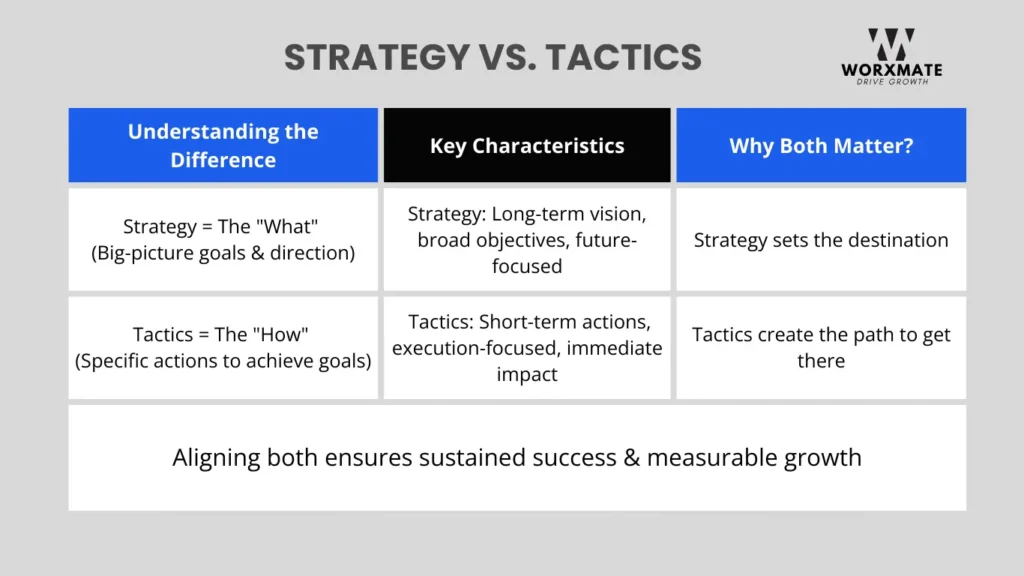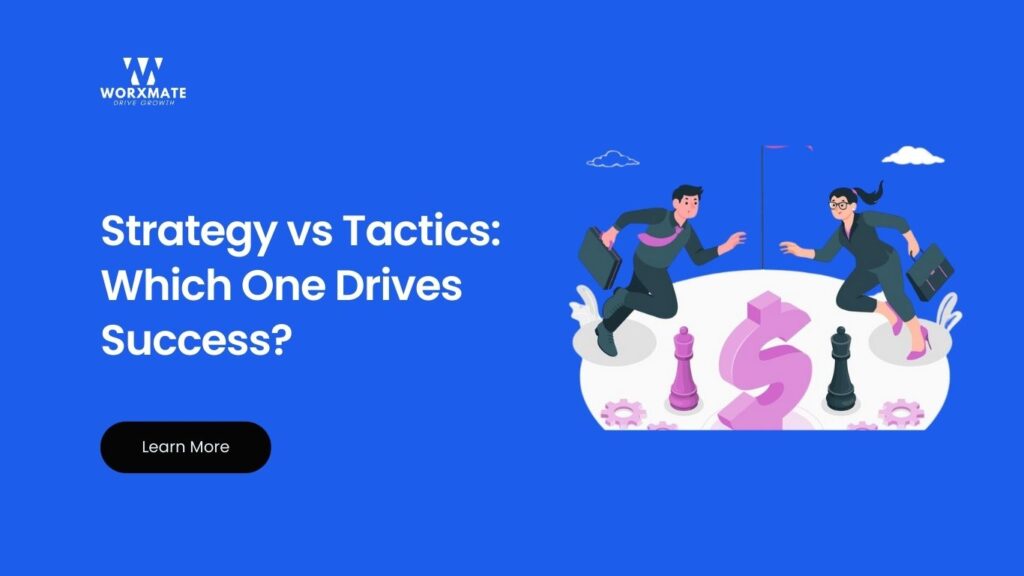Are you prepared to step it up? It’s time to recognize the difference between strategy and tactics, essential for creating a successful action plan.
A strategy is what you want to achieve; it’s about establishing objectives and figuring out how to reach them. Whereas tactics are the precise methods or plans you employ to achieve your goals and the actions you take along the route.
As per McKinsey & Company, only 25% of companies achieve sustainable, profitable growth over time. This statistic underscores the importance of a cohesive approach that integrates both strategic planning and tactical execution.
Without this alignment, businesses risk stagnation and may fall behind more agile competitors. Developing an effective strategy requires knowing when and how to use both. In this blog, we will talk about strategy vs tactics-what is better.
Knowing the Fundamentals- Defining Strategy and Tactics
Strategic vs Tactical Planning. The terms are frequently used interchangeably to refer to aspects of a business’s success, regardless of how big or small it is.

However, it becomes simpler to recognize the similarities as well as differences between strategy and tactics when you examine them more closely. Both are essential for your company to succeed and track its development more effectively.
The long-term, general objectives that a company or individual wishes to accomplish are outlined in strategic planning. Additionally, tactical planning delineates the immediate measures and actions necessary to accomplish the objectives outlined in the strategic plan. Let’s look into the details of these.
What is a Strategy?
A strategy is a long-term vision that defines the goals and direction of an organization. Every company requires a clear plan for its future. By outlining a company’s direction, vision, and overarching goal, a strategy offers this road map.
The main objectives of your strategy should be to reduce the advantages of your competitors, maximize your strengths, and keep an eye out for areas where you may grow.
A clear understanding of your objectives and an awareness of the unpredictability of the business environment are necessary for an effective strategy.
Businesses utilize strategies as a guide when making decisions. It gives you an understanding of how to follow the objectives you have set and gives you a sense of purpose and direction in regardless of unexpected challenges.
Read More: Product Launch Strategy
What is a Tactic?
A tactic is a short-term action that is taken to achieve the strategic goals. The steps and actions required to carry out your strategy are broken down into tactics.
While tactics are the day-to-day strategies you and your associates will employ on the ground to move your company closer to its ultimate goal, a strategy provides you with a broad overview of the big picture.
Compared to strategy, tactics are more precise and tangible. They frequently focus on performing specific actions and achieving short-term objectives.
Team members are given daily goals and accountability through tactics, which are practical rather than theoretical. Every strategy directly advances your company’s objectives and mission.
Understanding the difference between strategy and tactics is just the first step. The real challenge lies in ensuring they work together seamlessly.
Many organizations struggle with this alignment- teams may execute tasks effectively, but if those efforts don’t contribute to the larger strategic vision, growth stalls.
So, how can businesses ensure that day-to-day actions drive long-term success? One proven method is using OKRs (Objectives and Key Results).
How can OKRs improve your tactics and strategy?
Now that you understand the differences between strategy and tactics, let’s talk about a typical issue in an organization- lack of coordination.
How can you ensure that everyone’s methods are in line with one another and assist people in connecting their daily tasks to high-level strategies?
OKRs can be a quick, easy, and efficient approach to connect the two. They translate a strategy into achievable goals, which in turn inform tactical plans.
An objective outlines the necessary tasks and includes a list of Key Results that indicate how you will know you’ve completed them.
Anyone may quickly determine whether their methods are producing the desired results, whether those goals are in line with the strategy, and whether any of them require modification because OKRs have quantifiable KRs.
Methods for Measuring Strategy
You must select a few key performance indicators (KPIs) to monitor your strategy and assess performance. A good KPI answers questions about performance and provides suggestions for improving those figures using verifiable data.
For instance, a net promoter score (NPS) might be the KPI if your goal is to raise customer happiness. Don’t forget to establish goals that clearly define your KPIs and divide them into manageable time spans.
Methods for Measuring Tactics
It’s related to the layout and its elements when it comes to your techniques. Tactics usually have an initial and final date, specific resources allotted to them, and a few action items and checkpoints to assist them be accomplished. I want to emphasize that you should always have some person assigned to hold people accountable.
When taken as a whole, your tactics will provide you with the specific actions you need to monitor any aspect of your strategy, including associated KPIs or OKRs. Keep track of how resources are being employed and how much of your budget is left if you have committed resources to a tactic.
Which should come first, strategy vs tactics?
Whether you’re setting goals for business, fitness, or anything else, having an indicator or direction helps you stay on course. Therefore, the secret to success is to have long-term, approach-focused plans before developing tactics. To put it simply, plan your tactics after you have strategized.
Case Study- Blockbuster vs. Netflix- A Lesson in Strategy vs Tactics
In the early 2000s, Blockbuster was the dominant force in video rentals, with over 9,000 stores worldwide. At the same time, Netflix was a small startup offering DVD rentals by mail with a subscription-based model.
In 2000, Netflix approached Blockbuster with an offer to sell the company for $50 million. Blockbuster declined, believing its brick-and-mortar model would remain strong.
However, as consumer preferences shifted toward online streaming, Netflix strategically invested in digital innovation, while Blockbuster focused on short-term tactics like reducing late fees.
By 2010, Netflix had grown into a digital entertainment giant, while Blockbuster filed for bankruptcy. This case highlights the importance of long-term strategy over reactive tactics in an evolving market.
Wrapping Up
Any business hoping to effectively accomplish its objectives must comprehend the distinction between strategic vs tactical planning. Tactics are short-term measures that propel execution, whilst strategies offer long-term guidance.
By coordinating your strategy and tactics with your business goals, you may develop a coherent plan that advances your company.
Are you prepared to advance your company? Create a sound plan and implementable strategies that support your vision first. Keep in mind that the secret to keeping on course is to monitor your progress and make the required corrections. To improve your strategy and get more individualized advice, speak with professionals in the field.
Integrate strategy and tactics into your company’s activities, and see how you turn obstacles into chances and goals into accomplishments.
Get in touch with Worxmate right now to find out more about strategy implementations, business strategy vs tactics, and more! With the best OKR software, our team will assist you in achieving all of your business goals!




